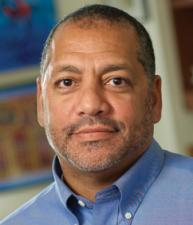“We look to the media to dig deeper, to open our eyes and our ears, and to go places where we can’t easily go,” said Professor Anthony Thompson. He was introducing a panel on “Media and the Movement: Deconstructing Journalism’s Role in Race and Inequality”, an October 2 event sponsored by the Center on Race, Inequality, and the Law (CRIL). At times, Thompson said, it seems as though the media is shining light on the wrong stories; nevertheless, he added, “for the first time in modern history, the world of journalism has a new face. The news cycle is changing, the types of stories that we are reading are changing, and those who write, edit, and broadcast the news are no longer the elite few.”
The event was an ongoing series of discussions held by CRIL, an interdisciplinary center dedicated to examining and exchanging ideas related to race, inequality, and leadership in the law. Thompson introduced the evening’s panelists as part of the “new face” of journalism, noting that they have spent their careers covering communities that have been “put on the margins, overlooked, or demonized.” Jamelle Bouie, chief political correspondent for Slate Magazine; Jennifer Gonnerman, staff writer for the New Yorker; Josie Duffy Rice, senior reporter at The Appeal and host of the Justice in America podcast; and Jake Sussman ’02, managing director of the Justice Collaborative, joined Thompson for an in-depth conversation on their experiences with criminal justice stories and the role that journalism can play in shaping social justice reform.
One approach to covering criminal justice stories is to highlight the experiences of individuals interacting with the criminal justice system. In a 2014 article, Gonnerman reported on Kalief Browder and his experience on Rikers Island, New York City’s primary jail complex. Browder had been arrested at the age of 16 on a robbery charge. He spent three years on Rikers without being convicted of a crime, and endured abuse by inmates and corrections officers and close to two years of solitary confinement before being released on the grounds of lack of evidence. Two years after his release, Browder died by suicide.
When President Obama banned solitary confinement for juveniles in federal prisons with an executive order in 2016, he cited Browder’s story. However, while the story effected change, Gonnerman said, “It was only after he took his own life that the story got the attention that he thought and I thought the situation deserved.”
“The Kalief Browder story, to me, what was so powerful about it was that it was a very ordinary story,” Bouie said, noting that often media outlets don’t have the resources to send reporters to investigate stories about ordinary individuals, as opposed to people in out-of-the-ordinary circumstances.
“There are a million untold stories happening every day in the courthouse,” said Sussman. The mission of his nonprofit organization, the Justice Collaborative, is to hold public officials accountable for justice reform. “The local courthouse is the driver of mass incarceration,” he said, and in the courthouse, “the most powerful person… is the prosecutor.”
Rice pointed to the election of reform-minded prosecutors such as Larry Krasner, district attorney in Philadelphia, and Kimberly Foxx, state’s attorney in Cook County, Illinois as evidence of progress. Both Foxx and Krasner ran on platforms that promised institutional change and a commitment to work towards ending mass incarceration. However, Rice cautioned, “Cook County jail is the most populous jail in America, and it’s not going to empty overnight.”
Sussman added that in addition to reporting on examples of injustice, journalists should also be tracking reform efforts. “When people do courageous things, that should be talked about,” he said.
The stories that are told in the media can also depend on who is choosing which stories to tell—and the panel agreed that there is a dearth of diversity in newsrooms today. “Journalism is still a shockingly white industry,” Bouie said. Journalism as an business is also in a moment of crisis, Gonnerman added: With newsrooms across the country hit by layoffs, many media outlets don’t have the resources necessary for long, extensively reported stories.
The panelists shared advice for law and journalism students who care about social and racial justice and who want to make a difference in their careers. Addressing aspiring journalists, both Gonnerman and Bouie emphasized the importance of persistence. The reporters who never give up, Gonnerman said, are the ones who break the stories.
Sussman wanted to assure the law students in the room that there is room for them in the criminal justice reform movement. “I am humbled by the many, many ways I have seen you can use a law degree,” he said, adding, “[You should] never be afraid to reinvent yourself in this movement and in this space.”
Rice added that one can choose either to work with existing structures to promote change from within, or to work to create new systems entirely: “There is a lot of room to shape a new reality.”
Watch the full video of the panel discussion (1 hour 30 minutes):
Posted October 23, 2018
